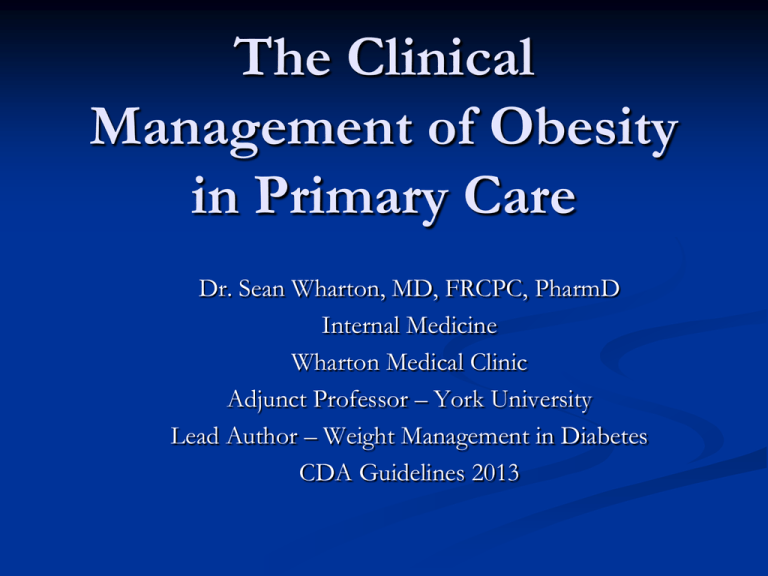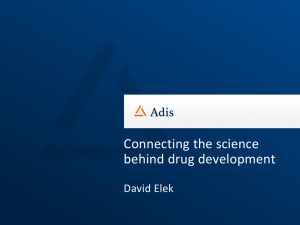
The Clinical
Management of Obesity
in Primary Care
Dr. Sean Wharton, MD, FRCPC, PharmD
Internal Medicine
Wharton Medical Clinic
Adjunct Professor – York University
Lead Author – Weight Management in Diabetes
CDA Guidelines 2013
Disclosures
Grants/support
CIHR
Heart and Stroke Foundation
MITACS – Research
Honoraria/Advisory Board
Novo-Nordisk
Merck
Bristol Myers Squibb
Abbott Pharmaceuticals
Eli-Lilly
AstraZeneca
Objectives
Understand the degree of the epidemic of
Obesity and the impact in Canada
Understand current systems to deliver bariatric
care in Canada.
Canadian Guidelines for Body Weight Classification in
Adults
Classification
BMI (kg/m2) Risk of Health Problems
Underweight
Normal weight
<18.5
18.5-24.9
Increased
Least
Overweight
Obese
Class I
25.0-29.9
≥30.0
30.0-34.9
Increased
Class II
Class III
35.0-39.9
≥40.0
High
Very High
Extremely High
Health Canada. Canadian Guidelines for Body Weight Classification in Adults. 204
Ottawa, ON: Health Canada; 2003. Publication H49-179/2003E.
Medical Complications of
Increased
Weight
Pulmonary disease
abnormal function
obstructive sleep apnea
hypoventilation syndrome
Nonalcoholic fatty liver
disease
Stroke
Cataracts
steatosis
steatohepatitis
cirrhosis
Coronary heart disease
Diabetes
Dyslipidemia
Hypertension
Gall bladder disease
Severe pancreatitis
Gynecologic abnormalities
Cancer
abnormal menses
infertility
polycystic ovarian syndrome
urinary incontinence
breast, uterus, cervix
colon, esophagus, pancreas
kidney, prostate
Osteoarthritis
Skin
fungal/bacterial infections
Gout
Phlebitis/DVT (Blood Clots)
venous stasis
Overweight - BMI 25 - 30
Greater in Men or Women?
•More overweight men
42% vs 30% women
•Android – Apple shape
Android – Apple Shape
Metabolic Syndrome
High Blood Pressure
Hypertension
High Cholesterol
High Blood Sugar
Diabetes
Cardiometabolic Risk
Visceral Fat vs Subcutaneous Fat
Visceral Fat
A
Courtesy: Steven Smith, MD
Pennington Biomedical Research Center
Subcutaneous Fat
B
Intra-abdominal Adiposity:
Autocrine Metabolically Active
Endocrine
Paracrine
Excess abdominal fat is typically accompanied
by ↑CRP, ↑FFAs, and adiponectin
PAI-1
Leptin
TGF-β
TNF-α
IL-6
TF
Adipsin/ASP
TNF-α
IL-6
Leptin
Reninangiotensin
system
Sex steroids
Glucocorticoids
Angiotensin
PAI-1
Adiponectin
Steroid
hormones
Kershaw EE, et al. J Clin Endocrinol Metab. 2004;89:2548-2556.
Lee YH, et al. Curr Diab Rep. 2005;5:70-75.
Boden G, et al. Eur J Clin Invest. 2002;32:14-23.
Ahima RS. Trends Endocrinol Metab. 2005;16:307-313.
AdipoQ
Morbid Obesity - BMI > 40
Greater in Men or Women??
• Morbid Obesity
• 4% women vs 1.5% men
•Gynaeoid Shape – Pear
•Less cardiometabolic
conditions
•Mechanical comorbidities
• Arthritis, urinary
incontinence, fatty liver
Gynaeoid Shape - Pear Shape
Curved hips and thighs
Small tapered waist
Due to estrogen
Low risk of metabolic
disease
Hard to lose fat from the
buttocks and thighs
Edmonton Obesity Staging
System (EOSS)
Stage 2
co-morbidity
Stage 1
moderate
Stage 3
moderate
Stage 0
Stage 4
Obesity
Sharma AM & Kushner RF, Int J Obes 2009
EOSS Predicts Mortality in
NHANES III
Padwal R, Sharma AM et al. CMAJ 2011
EOSS Predicts Mortality at Every Level of BMI
NHANES III
Padwal R, Sharma AM et al. CMAJ 2011
Obesity Treatment Pyramid
Psychological
Phases of Obesity Treatment
Phase I
Phase II
(Weight Loss)
(Weight-Loss Maintenance)
Weight
When you stop treatment,
the disease comes back!
3-6 months
Indefinitely
www.drsharma.ca
Energy Balance
Energy
Intake
Energy
Expenditure
What are the driving forces for this system??
Energy Balance
Metabolic Rate
Energy
Intake
Energy
Expenditure
Voluntary Movement
(Exercise)
What are the driving forces for this system??
An Aetiological Framework for Obesity
IN
Diet
OUT
Metabolism
SKELETAL MUSCLE
Sharma A, Padwal R. Obesity Reviews, 2009
Activity
Muscle vs Fat
1 lb of muscle burns
6 calories a day
1 lb of fat burns
2 calories a day
Heymsfield SB, Gallagher D, Wang Z. Ann N Y Acad Sci. 2000 May;904:290-7.
Energy to Muscle instead of Fat
6 Calories
1 muscle fibre
Resistance Exercise
Protein
3 Fat Cells
Inactivity
Carbohydrates
An Aetiological Framework for Obesity
IN
Diet
OUT
Metabolism
SKELETAL MUSCLE
AGE
Sharma A, Padwal R. Obesity Reviews, 2009
Activity
Age and Metabolism
Lose 2 % of BMR each decade after age 20
20 yo, woman, 5’5”, 250lbs
60 yo, woman, 5’5”, 250lbs
BMR = 1954
BMR = 1766 (8% less)
Can gain
10 – 20lbs/year
N. K. Fukagawa, L. G. Bandini and J. B. Young, Am J Physiol Endocrinol
Metab 259
An Aetiological Framework for Obesity
IN
Diet
OUT
Metabolism
SKELETAL MUSCLE
AGE
GENDER
Sharma A, Padwal R. Obesity Reviews, 2009
Activity
Gender and Metabolism
Men – 15% higher metabolism than women
50 yo, man,
5’7”, 250lbs
BMR = 2134
50 yo, woman,
5’7”, 250lbs
BMR = 1822
(15% less)
C Compher, et al. Journ Amer Dietetic Assoc. V.106,;6 881-903, 2006.
An Aetiological Framework for Obesity
IN
Diet
OUT
Metabolism
SKELETAL MUSCLE
AGE
GENDER
GENETICS
HORMONES
Sharma A, Padwal R. Obesity Reviews, 2009
Activity
Leptin (trying to keep you thin)
Stop eating
Increase metabolism
Leptin
MD Klok, S Jakobsdottir, ML Drent - Obesity reviews, 2007
DISCOVERY OF GASTROINTESTINAL HORMONES
1967 – Gastric Bypass
Rehfeld J, 2004
An Aetiological Framework for Obesity
IN
Diet
OUT
Metabolism
SKELETAL MUSCLE
AGE
GENDER
GENETICS
HORMONES
MEDICATIONS
Sharma A, Padwal R. Obesity Reviews, 2009
Activity
Selected Medications That
Can Cause Weight Gain
Psychotropic medications
Tricyclic antidepressants
Monoamine oxidase
inhibitors
Specific SSRIs
Atypical antipsychotics
Lithium
Specific anticonvulsants
-adrenergic receptor
blockers
Diabetes medications
Insulin
Sulfonylureas
Thiazolidinediones
Highly active antiretroviral
therapy
Tamoxifen
Steroid Hormones
Glucocorticoids
Progestational steriods
36/26
SSRI=Selective Serotonin Reuptake Inhibitor.
Consider Weight Effects When Selecting
Antihyperglycemic Medications
Weight Gain
Weight Effect (kg)
Insulin
+4.5 to 5.0
Thiazolidenediones (TZDs)
+4.2 to 4.8
Sulfonylureas
+1.6 to 2.6
Meglitinides
+ 0.7 to 1.8
Weight Neutral or Decrease Weight
Weight Effect (kg)
Metformin
-4.6 to 0.4
α-Glucosidase inhibitors
+0.0 to 0.2
Dipeptidyl peptidase-4 (DPP-4) inhibitors
+0.0 to 0.4
Glucagon-like peptide-1 (GLP-1) receptor
agonists
-1.3 to 3.0
Hollander, P. Diabetes Spectrum 2007; 20(3): 159-165
An Aetiological Framework for Obesity
IN
Diet
OUT
Metabolism
SKELETAL MUSCLE
AGE
GENDER
GENETICS
HORMONES
MEDICATIONS
WEIGHT LOSS
Sharma A, Padwal R. Obesity Reviews, 2009
Activity
Weight loss decreases metabolism
3% decrease for each 10lbs lost
50 yo, woman,
5’7”, 250lbs
50 yo, woman,
5’7”, 175lbs
BMR = 1822
BMR = 1496
(18% less)
R Leibel, M Rosenbaum, J Hirsch. Changes in Energy Expenditure Resulting
from Altered Body Weight. NEJM Vol 332:621-628 , 1995
Long-term weight-loss maintenance:
Meta-analysis
Anderson et al. Am J Clin Nutr, 2001
Weight
13 Studies
1,081pts
3% Weight Loss
average
5% Weight
Loss
40.5% of pts
10% Weight Loss
25% of pts
6 months
14%
4.5 years
Obesity Treatment Pyramid
Psychological
Bariatric Surgery Criteria
OBN (Ontario Bariatric Registry)
http://www.bariatricregistry.ca/
Criteria
BMI > 40
BMI 35 – 40
2 of the following: Diabetes, OSA, Heart Disease,
Hypertension not controlled on 2 medications
Bariatric Surgery
Effect on Cardiovascular Risk
A Systematic Review and Meta-Analysis of 22,090 Patients
Dyslipidemia
Diabetes
Sleepapnea
% resolved
Hypertension
62%
70%
77%
86%
Buchwald H, et al. JAMA 2004;292:1724
Canadian Institute of Health Information 2014
Roux-en-Y Gastric Bypass
Restrictive and Malabsorptive
Laparoscopic
30-35% Weight
10 – 20% regain
Mortality 1/500 (0.2%)
Morbidity 20-26/200
Covered by OHIP
$20,000
Sleeve Gastrectomy
Restrictive
Laparoscopic
30-35% Weight
10 – 20% regain
Mortality 1/500
(0.2%)
Morbidity 20-26/200
Covered by OHIP
$20,000
Laparoscopic Gastric Banding
Ring creates small pouch
15 – 25% Weight Loss
Frequent follow-up needed
Mortality - 1/10,000
Morbidity – 5%
Slippage
Erosion
Not covered by OHIP
$16 - $18,000
1995-“Who Would Have
Thought It?
Pories et al. Annals of Surgery
NIDDM is no longer an uncontrollable disease
The correction on NIDDM occurs within
days following gastric bypass, long before
significant weight loss has occurred
Decrease caloric intake and changes in incretin stimulation of
the islets by the gut may play a role
Surgery is doing more than
restriction
Shin et al. Int J Obes (Lond). May 2011; 35(5): 642–651.
Treatment Success
Change in Weight
Lifestyle (LS) ~3-5%
LS + Pharmacotherapy ~5-10%
LS + Surgery ~20-30%
Years
Source: Sharma, A
Medications
Orlistat (Xenical)
Decreases fat absorption
Diarrhea
Liver failure
Newer medications in the US
Liraglutide 3.0mg approved by FDA, submitted to
Health Canada
Diabetes Medications
and Weight Loss
GLP 1 analogues – Liraglutide, Exenatide
A1c decrease of 1%
Weight loss 5 – 10 lbs
SGLT2 inhibitors – Canagliflozin
A1c decrease 1%
Weight loss of 3 – 8 lbs
Principles for Obesity Treatment
• 2011 National Obesity Summit Workshop
Principles for Obesity Treatment
• 2011 National Obesity Summit Workshop
Diabetes Prevention Program:
Incidence of Diabetes
Cumulative Incidence
of Diabetes (%)
40
Placebo
Metformin
30
58%
Lifestyle
31%
20
10
0
0
0.5
1.0
1.5
2.0 2.5
Year
3.0
3.5
4.0
Reprinted from Diabetes Prevention Program Research Group. N Engl J Med. 2002;
346: 393-403. Copyright © 2002 Massachusetts Medical Society. All rights reserved.
Diabetes Prevention Program:
Weight Loss
Change in Weight (kg)
4
2
Placebo
0
Metformin
-2
-4
Lifestyle
-6
-8
0.0
0.5
1.0
1.5
2.0
Year
2.5
3.0
Reprinted from Diabetes Prevention Program Research Group. N Engl J Med. 2002;
346:393-403. Copyright © 2002 Massachusetts Medical Society. All rights reserved.
3.5
4.0
Barry at 404 lbs, BMI 60
Obesity Class III
Diabetes Type 2
OSA – CPAP
Hypertension
High Cholesterol
Developmental Delay
MEDs
Metformin, Glyburide
Ramipril, Lipitor
Barry’s Weight Loss Graph
Barry at 231lbs, BMI 33
176lbs lost, 43% WL
Current Medical Hx
Obesity Class I
OSA
Diabetes type 2
CPAP turned down
Diet controlled
Current Medications
No medications
Off – metformin, ramipril,
glyburide. Lipitor
Barry’s Weight Management Graph
2007
2014
Regain 110lbs
16% weight loss
2012
Loss 176 lbs
43% weight loss
Conclusion
Obesity has become a pandemic
Overweight in men should not be overlooked
Metabolic rate – 80% of energy expenditure
Leptin resistance can lead to obesity
Lifestyle modification is challenging
Bariatric Surgery – Gold Standard
For BMI >40
Medications can bridge the gap
Thank You!
Sarah Vanderlelie, BSc
Jennifer Kuk, PhD
Arya Sharma, MD
Rebecca Liu, MSc
Marcia Villafranca
WMC Team








